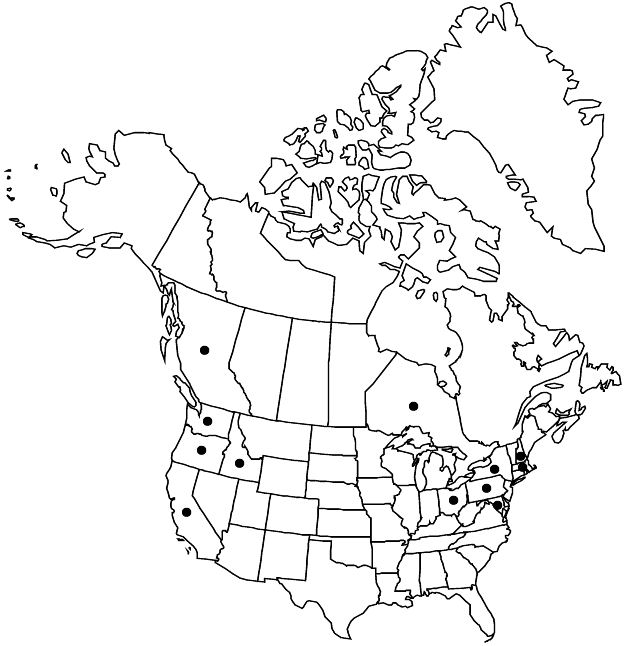Difference between revisions of "Prunus cerasifera"
Gartenkalender 4: 192. 1784.
FNA>Volume Importer |
imported>Volume Importer |
||
| (2 intermediate revisions by 2 users not shown) | |||
| Line 28: | Line 28: | ||
|elevation=0–900 m | |elevation=0–900 m | ||
|distribution=B.C.;Ont.;Calif.;Idaho;Md.;Mass.;N.H.;N.Y.;Ohio;Oreg.;Pa.;Wash.;se Europe. | |distribution=B.C.;Ont.;Calif.;Idaho;Md.;Mass.;N.H.;N.Y.;Ohio;Oreg.;Pa.;Wash.;se Europe. | ||
| + | |introduced=true | ||
|discussion=<p>The purple-leaved, pink-flowered cultivars of <i>Prunus cerasifera</i> are especially popular for ornamental use. The earliest purple form was introduced into European gardens about 1880 by M. Pissard, gardener to the Shah of Iran. <i>Prunus cerasifera</i> is widely used as a rootstock for commercial plums.</p> | |discussion=<p>The purple-leaved, pink-flowered cultivars of <i>Prunus cerasifera</i> are especially popular for ornamental use. The earliest purple form was introduced into European gardens about 1880 by M. Pissard, gardener to the Shah of Iran. <i>Prunus cerasifera</i> is widely used as a rootstock for commercial plums.</p> | ||
|tables= | |tables= | ||
| Line 52: | Line 53: | ||
|publication year=1784 | |publication year=1784 | ||
|special status=Introduced | |special status=Introduced | ||
| − | |source xml=https:// | + | |source xml=https://bitbucket.org/aafc-mbb/fna-data-curation/src/2e0870ddd59836b60bcf96646a41e87ea5a5943a/coarse_grained_fna_xml/V9/V9_622.xml |
|subfamily=Rosaceae subfam. Amygdaloideae | |subfamily=Rosaceae subfam. Amygdaloideae | ||
|tribe=Rosaceae tribe Amygdaleae | |tribe=Rosaceae tribe Amygdaleae | ||
Latest revision as of 22:58, 5 November 2020
Trees, sometimes suckering, 40–80 dm, not or slightly thorny. Twigs with axillary end buds, glabrous. Leaves deciduous; petiole 5–20 mm, glabrous except for a few hairs on adaxial surface, eglandular; blade ovate, elliptic, or obovate, 3–7 × 1.5–3.5 cm, base obtuse, margins singly to doubly crenate-serrate, teeth blunt, glandular, apex obtuse to acute, abaxial surface hairy along midribs and veins, adaxial glabrous. Inflorescences usually solitary flowers, sometimes 2-flowered fascicles. Pedicels (4–)10–18 mm, glabrous. Flowers blooming before leaf emergence; hypanthium campanulate, 2–4 mm, glabrous externally; sepals reflexed to spreading, oblong-ovate, 2–4 mm, margins glandular-toothed to nearly entire, eciliate, abaxial surface glabrous, adaxial hairy at bases; petals white (reddish pink in cultivars), elliptic to suborbiculate, 7–14 mm; ovaries glabrous. Drupes purple-red to yellow, sometimes glaucous, ovoid, ellipsoid, or globose, 15–30 mm, glabrous; mesocarps fleshy; stones ellipsoid to ovoid, ± to strongly flattened. 2n = 16.
Phenology: Flowering Feb–Apr; fruiting Jun–Aug.
Habitat: Roadsides, stream banks, canyons, chaparral
Elevation: 0–900 m
Distribution

Introduced; B.C., Ont., Calif., Idaho, Md., Mass., N.H., N.Y., Ohio, Oreg., Pa., Wash., se Europe.
Discussion
The purple-leaved, pink-flowered cultivars of Prunus cerasifera are especially popular for ornamental use. The earliest purple form was introduced into European gardens about 1880 by M. Pissard, gardener to the Shah of Iran. Prunus cerasifera is widely used as a rootstock for commercial plums.
Selected References
None.